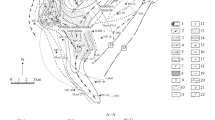Abstract
Three small intrusions in Ketilidian gneisses near Julianehaab comprise sheets and veins of olivine-magnetite-grunerite or magnetite-amphibole rocks partly surrounded by garnetiferous hornblende-biotite granitoid rock. The latter “skin” locally widens out into diffuse bodies of fayalite-orthopyroxene-quartz syenite or monzonite and biotite “granite”, which show layering similar to that resulting from gravity settling of crystals. Near the intrusions the country rocks lose their foliation and have been partially melted. Intrusion probably occurred at the close of regional metamorphism ∼ 1,750–1,780 m.y. ago, just prior to emplacement of the rapakivi granite suite of South Greenland. The mafic minerals of the intrusions are markedly enriched in iron and, in the case of olivine, orthopyroxene, grunerite and garnet, in manganese as well: olivine Fa90Te5Fo5; orthopyroxene (inverted pigeonite) Ca2Fe77Mn6Mg15; calciferous amphiboles are typically hastingsitic; biotites generally have Fe/Fe+Mg ratios of 0.8; garnets are almandine-grossularite-spessartine mixtures; essentially pure magnetite is the dominant oxide mineral and ilmenite is only moderately manganiferous. Crystallization of the mafic rocks appears to have followed the trend of the quartz-fayalite-magnetite buffer curve from perhaps ∼800°C to <550°C at pressures, calculated from thermodynamic considerations, of 4 to 5 kb. However, the presence of Mn makes estimates of pressure and temperature uncertain. Comparison with other late- to post-orogenic intrusions—the South Greenland and Finnish rapakivi granite suites, the Labrador “adamellite” complex and the Pikes Peak batholith of Colorado—reveals both similarities and differences, particularly with respect to mineral parageneses, depth of emplacement and manganese enrichment.
Similar content being viewed by others
References
Windley, B.F.: The Precambrian geology of the Sârdloq area, South Greenland. Rapp. Grønlands Geol. Unders. 5 (1966)
Allaart, J.H., Bridgwater, D., Henriksen, N.: Pre-Quaternary geology of Southwest Greenland and its bearing on North Atlantic correlation problems. In: North Atlantic-geology and continental drift (ed.: M. Kay). Am. Assoc. Petroleum Geologists Mem. 12, 859–882 (1969)
Bridgwater, D., Escher, A., Jackson, G.D., Taylor, F.C., Windley, B.F.: Development of the Precambrian Shield in West Greenland, Labrador, and Baffin Island. In: Arctic geology (ed.: M. G. Pitcher). Am. Assoc. Petroleum Geologists Mem. 19, 99–116 (1973)
Gulson, B.L., Krogh, T.E.: U/Pb zircon studies on the age and origin of post-tectonic intrusions from South Greenland. In: Report of activities, 1971. Rapp. Grønlands Geol. Unders. 45, 48–53 (1972)
Allaart, J. H.: Basic and intermediate igneous activity and its relationships to the evolution of the Julianehaab granite, South Greenland. Bull. Grønlands Geol. Unders. 69, (1967)
Spry, A.: Metamorphic textures. Oxford: Pergamon Press 1969
IUGS Subcommission on the Systematics of Igneous Rocks: Plutonic rocks. Geotimes 18, no. 10, 26–30 (1973)
Deer, W.A., Howie, R.A., Zussman, J.: Rock-forming minerals, Vol. 2. London: Longmans 1963
Klein, C., Jr.: Cummingtonite-grunerite series: a chemical, optical and X-ray study. Am. Mineralogist 49, 963–982 (1964)
Leake, B.E.: A catalog of analyzed calciferous and subcalciferous amphiboles together with their nomenclature and associated minerals. Geol. Soc. Am. Spec. Papers 98 (1968)
Kurepin, V.A.: Conditions for stability of the MgSiO3-FeSiO3 pyroxenes. Geochem. International 7, 673–676 (1970)
Wood, B.J., Strens, R.G.J.: The orthopyroxene geobarometer. Earth Planet. Sci. Lett. 11, 1–6 (1971)
Smith, D.: Stability of the assemblage iron-rich orthopyroxene-olivine-quartz. Am. J. Sci. 271, 370–382 (1971)
Lindsley, D.H., Tso, J., Heyse, J.V.: Effect of Mn on the stability of pigeonite. Abstr. with Programs Geol. Soc. Am. 6, 846–847 (1974)
Bonnichsen, B.: Metamorphic pyroxenes and amphiboles in the Biwabik Iron Formation, Dunka River area, Minnesota. Mineral. Soc. Am. Spec. Papers 2, 217–239 (1969)
Simmons, E.C., Lindsley, D.H., Papike, J.J.: Phase relations and crystallization sequence in a contact-metamorphosed rock from the Gunflint Iron Formation, Minnesota. J. Petrol. 15, 539–565 (1974)
Smith, D.: Iron-rich pyroxenes. Carnegie Inst. Wash. Yearbook 69, 285–290 (1971)
Saxena, S.K.: Thermodynamics of rock-forming crystalline solutions. New York: Springer 1973
Schürmann, K.: Hydrothermale experimentelle Untersuchungen an metamorphen monoklinen Hornblenden, Teil I: Zur Stabilität der Cummingtonite. Neues Jahrb. Mineral. Monatsh. 1967, 270–284 (1967)
Buddington, A.F., Lindsley, D.H.: Iron-titanium oxide minerals and their synthetic equivalents. J. Petrol. 5, 310–357 (1964)
Wones, D.R., Eugster, H.P.: Stability of biotite: experiment, theory and application. Am. Mineralogist 50, 1228–1272 (1965)
Wones, D.R.: Stability of biotite: a reply. Am. Mineralogist 57, 316–317 (1972)
Simonen, A: Olivine from rapakivi. Compt. Rend. Soc. Géol. Finlande 33, 371–376 (1961)
Simonen, A., Vorma, A.: Amphibole and biotite from rapakivi. Bull. Comm. Géol. Finlande 238 (1969)
Smith, D.: Pyroxene-olivine-quartz assemblages in rocks associated with the Nain anorthosite massif. Labrador. J. Petrol. 15, 58–78 (1974)
Bridgwater, D., Sutton, J., Watterson, J.: Crustal downfolding associated with igneous activity. Tectonophysics 21, 57–77 (1974)
Wheeler, E.P., II: Minor intrusives associated with the Nain anorthosite. In: Origin of anorthosite and related rocks (ed.: Y.W. Isachsen). New York State Mus. and Science Serv. Mem. 18, 189–206 (1968)
Vorma, A.: Alkali feldspars of the Wiborg rapakivi massif in southeastern Finland. Bull. Comm. Géol. Finlande 246 (1971)
Wetherill, G.W., Kouvo, O., Tilton, G.R., Gast, P.W.: Age measurements on rocks from the Finnish Precambrian. J. Geol. 70, 74–88 (1962)
Barker, F., Wones, D.R., Sharp, W.N., Desborough, G.A.: The Pikes Peak batholith, Colorado Front Range, and a model for the origin of the gabbro-anorthosite-syenite-potassic granite suite. Precambrian Res. 2, 97–160 (1975)
Carmichael, I.S.E.: The iron-titanium oxides of salic volcanic rocks and their associated ferromagnesian silicates. Contrib. Mineral. Petrol. 14, 36–64 (1967)
Author information
Authors and Affiliations
Rights and permissions
About this article
Cite this article
Frisch, T., Bridgwater, D. Iron- and manganese-rich minor intrusions emplaced under late-orogenic conditions in the proterozoic of South Greenland. Contrib. Mineral. Petrol. 57, 25–48 (1976). https://doi.org/10.1007/BF00392850
Received:
Accepted:
Issue Date:
DOI: https://doi.org/10.1007/BF00392850




